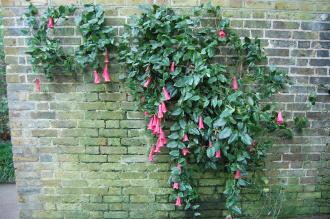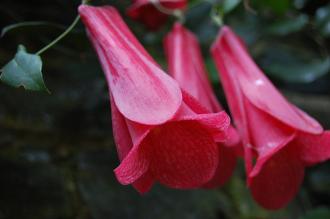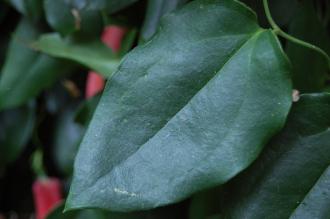
Lapageria rosea (28/10/2014, Kew Gardens, London)
Position: Partial to full shade
Flowering period: Late summer to autumn
Soil: Moist, neutral to acid
Eventual Height: 5m
Eventual Spread: 5m
Hardiness: 9a, 9b, 10a, 10b, 11
Family: Philesiaceae
Lapageria rosea is a slow growing evergreen climber with a twining habit. Its dark leaves are leathery, lanceolate to ovate with entire margins, up to 10cm long and 5cm broad. Its pink/ red waxy flowers are pendulous bell shaped and up to 7.5cm long. Its fruit is an elogated berry.

Lapageria rosea Flower (28/10/2014, Kew Gardens, London)
Lapageria rosea, commonly known as Chilean Bellflower or Copihue, is native to Chile. In its native habitat it grows in humid shady woodlands. Lapageria rosea is the only species within this genus. It is the national flower of Chile.
The etymological root of the binomial name Lapageria is named after Marie Josephine Rose Tascher de la Pagerie (1763–1814), Napoleon’s Empress Josephine, avid collector of roses at Malmaison. Rosea is from the Latin meaning ‘rose coloured’.
The landscape architect may find Lapageria rosea useful as an evergreen climber with attractive flowers suitable for shady locations. It prefers a shelter location.
Ecologically, Lapageria rosea flowers are pollinated by humming birds and pollinating insects.

Lapageria rosea Leaf (28/10/2014, Kew Gardens, London)
The Royal Horticultural Society has given Lapageria rosea their prestigious Award of Garden Merit in 1993.
Lapageria rosea prefers moist, fertile, humus rich, well-drained soils. It prefers a neutral to acid pH of soil. It dislikes dry soils.
Lapageria rosea requires little maintenance. Necessary pruning should be carried out after flowering.

